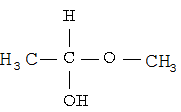Definition of Hemiacetal
A hemiacetal is a chemical compound that is organic and is formed when the chiral carbon is connected to two atoms of oxygen. One oxygen atom belongs to the alcohol (-OH) function group whereas the other oxygen is of ether (R-O-R). In simple words, the addition of alcohol to aldehyde results in a hemiacetal.
Example of Hemiacetal:
An example of the hemiacetal is 1-methoxyethan-1-ol. In this case, every alkyl (R) group is methane, a CH3. This is known to be the simplest of all the hemiacetals.
They can be synthesized in several ways which include partial hydrolyzing the acetals, adding the alcohol to the carbonyl carbon of aldehyde by nucleophilic addition, etc.
View More Organic Chemistry Definitions
Related Questions of Hemiacetal
The following sequence, beginning with a cyclic hemiacetal (compound A
The compound fusarisetin A (isolated from a soil fungus) displays
Compound A has the molecular formula C8H14O2. Upon treatment with catalytic
Draw the cyclic hemiacetal that is formed when each of the following
The following compound has one aldehyde group and two OH groups.
Draw a mechanism for the acid-catalyzed cyclization of l-
Draw the cyclic hemiacetal that is formed when each of the following
i. draw the Fischer projection for each carbohydrate below ii
Identify each of the following structures as a hemiacetal or acetal.
Identify each of the following compounds as a hemiacetal or acetal:
Show All



